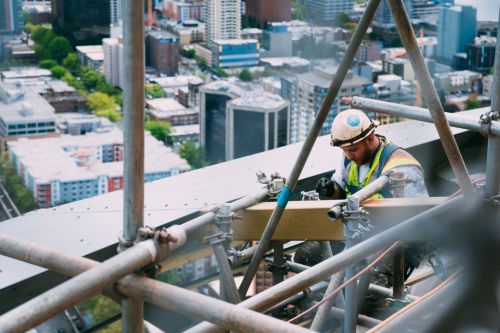 In 2017/2018, falls from height remained the single most common cause for an occupational fatality in the UK. Around 28% of all recorded fatal injuries in the workplace resulted from a fall. Almost 50% of all fall from height related deaths over the last years were in the construction industry, with an average of 19 cases annually.
In 2017/2018, falls from height remained the single most common cause for an occupational fatality in the UK. Around 28% of all recorded fatal injuries in the workplace resulted from a fall. Almost 50% of all fall from height related deaths over the last years were in the construction industry, with an average of 19 cases annually.
Unfortunately, falls remain a lethal threat to many people working in manual labour, as well as in many other industries. Just this month (August), three UK companies have been fined after workers suffered falls from height. Luckily, the victims escaped with non-life-threatening injuries, yet, the cause of the problem remains: companies need to step up their health and safety game to reduce the number of occupational fatalities.
Why falls from height are so dangerous
More so than any other type of accident, falls from height have a very high potential of causing serious spinal, head and neck injuries, which can leave the worker severely disabled or lead to death.
Whilst the number of non-fatal accidents caused by falls from a height is relatively low in comparison, the fatality-rate is extremely high. And not surprisingly so – the chances of surviving a fall from 10 meters are low. But it doesn’t depend on the height, even a fall from 2 meters can be deadly when landing on the wrong surface or object.
Therefore, making sure that the workspace is safeguarded against fall hazards should be a top priority for any business owner, worker or even hobby tinkerer. These five simple, hands-on tips should be applied in any situation, whether professional or crafting at home:
Using an anchor point
Especially when working on unprotected roofs or close to edges, being tied to a safe and secure anchor point will prevent falls very easily. From a simple D-ring connection to complete lifeline systems, fall protection anchors can be as straight-forward or complex as needed for the task at hand.
Training for the situation
A very basic but also very important step is the safety training. Many companies like to skip hiring a professional health and safety consultant to assess the task and train workers on how to avoid injuries and accidents. Needless to say, cutting costs is absolutely not advisable when lives depend on it.
Checking equipment thoroughly
Every piece of equipment, whether they are ladders, belts, hard hats or other life-saving devices, should be checked in detail(!) before use. That includes looking for any visual defects or risks, and, also making sure everything is in pristine condition. Especially severe weather conditions, like rain or frost, can interfere with equipment in dangerous ways.
Thinking about others
If the site is frequented by civilians, special precautions need to be taken to make sure both workers, and by-passers are kept safe. Setting up fences, warning signs and safety nets will protect outsiders from being struck by falling objects, for example. At the same time, workers don’t need to worry about civilians interrupting the task and creating a dangerous situation.
Knowing when to stop
Trying to go beyond what is physically possible is not admirable, it is a potential threat to everyone involved in the operation. If workers feel sick, dizzy or simply not prepared for the task ahead, they should voice their concerns: it is likely something is wrong. Whether instructions weren’t clear enough, or the body (or mind) are getting tired in the afternoon: better to be safe than sorry.
Working at heights doesn’t have to feel any different from working on the solid ground. Sticking to a safety check-list, asking questions when things are unclear and managing each other’s health can make work more enjoyable and productive.
Katharina Busch is content writer at Arinite.



